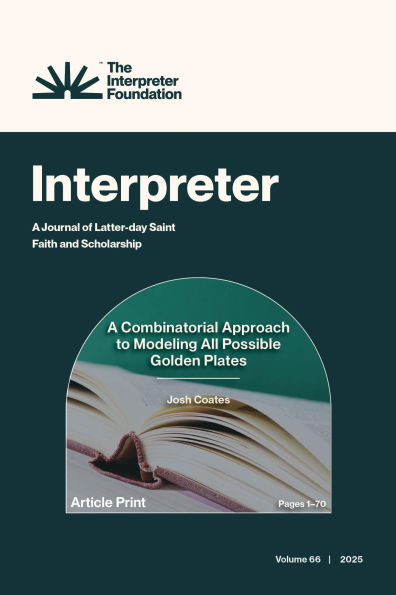A Combinatorial Approach to Modeling All Possible Golden Plates
Abstract: Historical reports containing information about the properties of the golden plates provide upper and lower bounds for calculating possible configurations of their size, weight, and material composition, as well as the possible properties of reformed Egyptian. This study employs a two-part process to analyze these configurations. First, it examines the physical properties of the plates, generating over 4 billion possible combinations. Second, it analyzes the nature of the writing on the plates, assuming the translated English text of the Book of Mormon is directly representative of the reformed Egyptian engravings. This process involves calculating and filtering combinations based on historical accounts, physical constraints, and linguistic considerations. The study demonstrates that while most configurations are unworkable, nearly one million configurations remain both physically possible and consistent with the documentary record. Key findings suggest the plates likely had less than 20% gold content, weighed more than 54 lb., contained between 187 and 259 plates, and had dimensions slightly smaller than, but within 10% of, Joseph Smith's description. The writing on the plates likely averaged less than 5 mm square, with each character representing at least three English characters, similar to Egyptian Demotic. Although there are inherent limitations in historical analysis of this kind, this mathematical approach provides a novel perspective on the physical reality of the plates.
1147685600
A Combinatorial Approach to Modeling All Possible Golden Plates
Abstract: Historical reports containing information about the properties of the golden plates provide upper and lower bounds for calculating possible configurations of their size, weight, and material composition, as well as the possible properties of reformed Egyptian. This study employs a two-part process to analyze these configurations. First, it examines the physical properties of the plates, generating over 4 billion possible combinations. Second, it analyzes the nature of the writing on the plates, assuming the translated English text of the Book of Mormon is directly representative of the reformed Egyptian engravings. This process involves calculating and filtering combinations based on historical accounts, physical constraints, and linguistic considerations. The study demonstrates that while most configurations are unworkable, nearly one million configurations remain both physically possible and consistent with the documentary record. Key findings suggest the plates likely had less than 20% gold content, weighed more than 54 lb., contained between 187 and 259 plates, and had dimensions slightly smaller than, but within 10% of, Joseph Smith's description. The writing on the plates likely averaged less than 5 mm square, with each character representing at least three English characters, similar to Egyptian Demotic. Although there are inherent limitations in historical analysis of this kind, this mathematical approach provides a novel perspective on the physical reality of the plates.
0.0
In Stock
5
1

A Combinatorial Approach to Modeling All Possible Golden Plates

A Combinatorial Approach to Modeling All Possible Golden Plates
eBook
FREE
Related collections and offers
0.0
In Stock

Product Details
| BN ID: | 2940184696027 |
|---|---|
| Publisher: | Interpreter Foundation |
| Publication date: | 06/19/2025 |
| Series: | Interpreter: A Journal of Latter-day Saint Faith and Scholarship , #66 |
| Sold by: | Barnes & Noble |
| Format: | eBook |
| File size: | 8 MB |
About the Author
From the B&N Reads Blog
